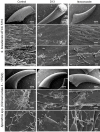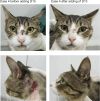Combination therapy of itraconazole and an acylhydrazone derivative (D13) for the treatment of sporotrichosis in cats
- PMID: 38647345
- PMCID: PMC11237696
- DOI: 10.1128/spectrum.03967-23
Combination therapy of itraconazole and an acylhydrazone derivative (D13) for the treatment of sporotrichosis in cats
Abstract
Acylhydrazone (AH) derivatives represent a novel category of anti-fungal medications that exhibit potent activity against Sporothrix sp., both in vitro and in a murine model of sporotrichosis. In this study, we demonstrated the anti-fungal efficacy of the AH derivative D13 [4-bromo-N'-(3,5-dibromo-2-hydroxybenzylidene)-benzohydrazide] against both planktonic cells and biofilms formed by Sporothrix brasiliensis. In a clinical study, the effect of D13 was then tested in combination with itraconazole (ITC), with or without potassium iodide, in 10 cats with sporotrichosis refractory to the treatment of standard of care with ITC. Improvement or total clinical cure was achieved in five cases after 12 weeks of treatment. Minimal abnormal laboratory findings, e.g., elevation of alanine aminotransferase, were observed in four cats during the combination treatment and returned to normal level within a week after the treatment was ended. Although highly encouraging, a larger and randomized controlled study is required to evaluate the effectiveness and the safety of this new and exciting drug combination using ITC and D13 for the treatment of feline sporotrichosis.
Importance: This paper reports the first veterinary clinical study of an acylhydrazone anti-fungal (D13) combined with itraconazole against a dimorphic fungal infection, sporotrichosis, which is highly endemic in South America in animals and humans. Overall, the results show that the combination treatment was efficacious in ~50% of the infected animals. In addition, D13 was well tolerated during the course of the study. Thus, these results warrant the continuation of the research and development of this new class of anti-fungals.
Keywords: Sporothrix; acylhydrazone; anti-fungal therapy; cats; fungal infection; itraconazole; sporotrichosis; terbinafine.
Conflict of interest statement
M.D.P. is a co-founder and CSO; J.B.M. is a co-founder and CEO; and J.M. is a co-founder and chief research and development officer of MicroRid Technologies Inc. The goal of MicroRid Technologies Inc. is to develop new anti-fungal agents of therapeutic use. All other authors declare no competing interests.
Figures







Similar articles
-
Feline sporotrichosis: a case series of itraconazole-resistant Sporothrix brasiliensis infection.Braz J Microbiol. 2021 Mar;52(1):163-171. doi: 10.1007/s42770-020-00290-5. Epub 2020 May 9. Braz J Microbiol. 2021. PMID: 32388779 Free PMC article.
-
Plasma itraconazole concentrations during treatment of feline sporotrichosis.Med Mycol. 2024 Aug 2;62(8):myae076. doi: 10.1093/mmy/myae076. Med Mycol. 2024. PMID: 39049454
-
Clotrimazole is highly effective in vitro against feline Sporothrix brasiliensis isolates.J Med Microbiol. 2017 Nov;66(11):1573-1580. doi: 10.1099/jmm.0.000608. Epub 2017 Oct 6. J Med Microbiol. 2017. PMID: 28984226
-
Advances and challenges in the management of feline sporotrichosis.Rev Iberoam Micol. 2022 Jul-Dec;39(3-4):61-67. doi: 10.1016/j.riam.2022.05.002. Epub 2022 Jul 13. Rev Iberoam Micol. 2022. PMID: 35840526 Review.
-
Guideline for the management of feline sporotrichosis caused by Sporothrix brasiliensis and literature revision.Braz J Microbiol. 2021 Mar;52(1):107-124. doi: 10.1007/s42770-020-00365-3. Epub 2020 Sep 29. Braz J Microbiol. 2021. PMID: 32990922 Free PMC article. Review.
References
-
- de Carvalho JA, Beale MA, Hagen F, Fisher MC, Kano R, Bonifaz A, Toriello C, Negroni R, Rego RS de M, Gremião IDF, Pereira SA, de Camargo ZP, Rodrigues AM. 2021. Trends in the molecular epidemiology and population genetics of emerging Sporothrix species. Stud Mycol 100:100129. doi:10.1016/j.simyco.2021.100129 - DOI - PMC - PubMed
-
- Boechat JS, Oliveira MME, Gremião IDF, Almeida-Paes R, Machado A de S, Zancopé-Oliveira RM, Oliveira R de V, Morgado DS, Corrêa ML, Figueiredo ABF, Menezes RC, Pereira SA. 2022. Sporothrix brasiliensis and feline sporotrichosis in the metropolitan region of Rio de Janeiro, Brazil (1998-2018). J Fungi (Basel) 8:749. doi:10.3390/jof8070749 - DOI - PMC - PubMed
MeSH terms
Substances
Supplementary concepts
Grants and funding
- PR190642/U.S. Department of Defense (DOD)
- SEI E-26/204.281/2021/Fundação Carlos Chagas Filho de Amparo à Pesquisa do Estado do Rio de Janeiro (FAPERJ)
- AI116420/HHS | NIH | National Institute of Allergy and Infectious Diseases (NIAID)
- R01 AI116420/AI/NIAID NIH HHS/United States
- R01 AI125770/AI/NIAID NIH HHS/United States
LinkOut - more resources
Full Text Sources
Miscellaneous

